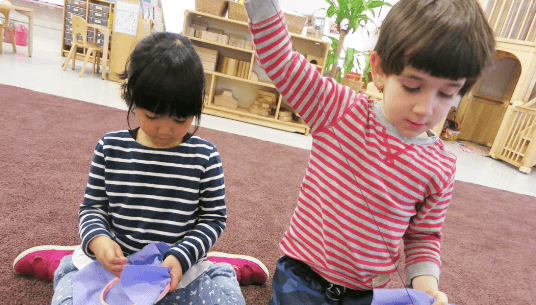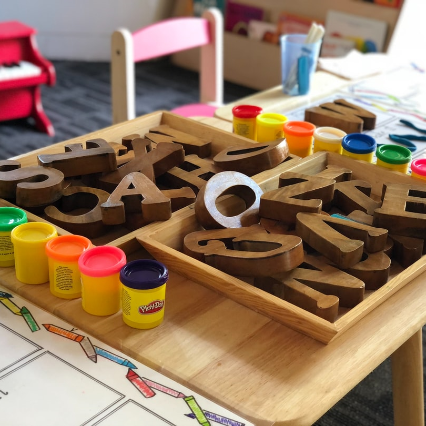
4s Program
Overview
The 4s curriculum builds upon the social and cognitive skills put into place during the 3s year. Our goal for children in the 4s program is to encourage them to think creatively and expansively while simultaneously exposing them to the skills and information they will need to be successful in their kindergarten year. Research indicates that young children learn most effectively when they are engaged in interaction rather than in receptive or passive activities. Therefore as the children’s skills become more sophisticated the emergent curriculum approach is highlighted and emphasized and more time is now spent as a group; developing ideas and focusing on curriculum topics. Teachers at CEDS are trained to listen to the children, observe their play and discuss with them at circle time topics that may have piqued their interest. Based on the children’s observations and discussions, the teachers and children invest themselves in projects or units that provide enriching opportunities to closely and thoroughly examine aspects of the children’s environment, curiosities, and knowledge base. Typically two to three units are explored during the year. Children learn to use a variety of research dispositions and strategies, including the use of books, experts, and internet searches in order to discover the answers to their questions. The teachers facilitate learning in a variety of settings, including large and small group experiences, trip-taking, and special guest teachers.
Integrated into the units are complementary skills in math, science, physical development, and language arts along with consistent opportunity for the children to build upon their language and fine motor skills. The curriculum builds on the children’s developing ability to use reason and logic in problem-solving. They are beginning to enjoy working together collaboratively on projects and their ability to use language to negotiate has increased. They are becoming more cognizant of words and how words or letters are used in combination with pictures to tell a story. They begin to focus their attention on the connection between particular sounds and letters. They are beginning to develop their sense of what it means to be a reader and writer and can illustrate and dictate to teachers their own books. They continue to easily memorize the words to a song and delight in rhythm of rhymes or silly songs. Mathematically, they like counting and are beginning to make comparisons such as longer than or smaller than and have put into place an understanding of one-to-one correspondence. At CEDS we believe computers should enhance curriculum rather than dictate it and as a result our 4 year olds, with the assistance of a teacher, utilize the computer in the exploration of their curriculum topics. Overall this stimulating approach to curriculum accentuates the use of problem-solving, research, and creativity.
4s Schedule & Tuition
4s Programming
The daily class schedule for the 4s becomes more structured yet is still flexible with regard to free play in the classroom or in the garden/gym. The day begins with a welcome meeting and is followed by gym, snack, center time, special activities and skill building games. Many new responsibilities are introduced to the children and the level of project and group work becomes more sophisticated. A new period of “table time” is introduced to children. During table time, children work together as a group on a similar activity for ten to fifteen minutes. Table time occurs every other week. The sessions are devoted to drawing and reflecting in journals or specific activities selected by the teachers involving explorations in math, science and fine motor skills.
Working with different artistic mediums continues to play a major role in the curriculum. The children will be exposed to similar materials as the year before, such as paint, collage, clay, and wood, but will use them in new ways. They will also expand their repertoire to mosaics, stained glass and sculpture. The children are also given an introduction to the vocabulary and tools of art. Art projects may take more than one day to complete, instilling within the children an understanding that they do not need to rush a project through to completion. Through this curriculum, art becomes another language, which allows the children to explore themselves and the world around them.
In addition to a mid morning snack, our long-day children stay for lunch which they bring from home each day. As mandated by the Department of Health our Long Day children are required to have a period of rest for at least 20 minutes at some point in their day. This typically happens after the children eat lunch.
The 4s children have a library period each week. During their library session, the children participate in a group literacy experience that typically builds upon previous work. Reading aloud, dramatic performance or collaboratively written stories interchange as they explore relevant themes that reflect their units of study or significant events in their lives. The children check out books to take home and return. The library time is also designed to expose children to the different genres of literature, including poetry, fiction, non-fiction, and music.
4s Curriculum Overview
4s Curriculum
Area
Concept & Theme
Activities & Experiences
- Gross Motor:
More advanced use of large muscle development, coordination, and control including arms, legs and torso.
- Climbing/running/jumping
- Balancing
- Hopping
- Dancing
- Building with blocks
- Cooperative movement games involving multiple steps
- Fine Motor:
Increased focus on developing dexterity and facility of manipulation of smaller muscle groups including hands and fingers.
- Using table toys and manipulatives (e.g. peg boards, blocks, puzzles,
beads, Legos) - Art materials
- Developing skills with scissors
- Consolidating pencil grip
- Supporting children in representational drawing
- Journals
- Table Time
- Community
- Respect for others and different points-of-view
- Accepting limits
- Turn-taking
- Using multiple approaches to solve conflicts
- Collaboration/Teamwork
- Developing a sense of
compassion, fair play & personal integrity - Encourage global awareness
- Strengthening sense of
independence and self-confidence
- Discussions
- Drawing
- Dictating ideas
- Collaborating on class projects
- Voting on curriculum unit investigations
- Reading books
- Making individual and class books
- Circle time
- Job chart
- Working cooperatively during free play
- Discussing social conventions
- Trips within community
- Class visitors
- Exploration of similarities and differences
- Emergent literacy
- Beginning phonological
awareness, sound-symbol correspondence, and letter recognition - Concepts about print
- Alphabet
- Reading aloud stories and poems
- Dictating and acting out stories
- Drawing
- Song
- Making books
- Approximate spelling
- Alphabet exploration
- Library
- Mathematical language
- Developing number sense
- Sorting, comparing,
classifying - One-to-one
correspondence - Predicting/estimating
- Measuring
- Creating and reading graphs
- Repeated patterns
- Recognizing numerals
- Writing numbers
- Recognition of 2-D and 3-D shapes
- Block building
- Calendar
- Taking attendance
- Pattern blocks
- Observing and touching
- Discussing and
questioning - Forming predictions and
experimenting
- Seasons
- Weather
- Five senses
- In-depth exploration of topics initiated by the children
- Following multiple steps
- Gross motor development
- Appreciation of music
- Waiting your turn
- Sense of body in space
- Running, stretching, etc.
- Listening
- Listening
- Fine Motor
- Language of Art
- Tools of Art
- Focus
- Exposure to various application and utilization methods of different materials
- Discussing the art projects with peers
- Exploration of different mediums
- Thinking about design before beginning project
Let's build a bright future for your child!
Start the application process now!
Our Other Programs

2s Program

